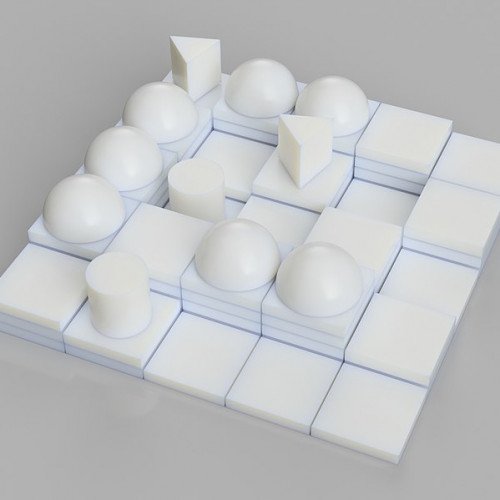SANTORINI VS SENET

SANTORINI
Santorini is an abstract strategy board game for 2-4 players designed and released in 2004 by Gordon Hamilton and republished via Kickstarter in 2016 by Roxley Games. Inspired by the architecture of cliffside villages on Santorini Island in Greece, and primarily designed for two players, the game is played on a grid where each turn players build a town by placing building pieces up to three levels high. To win the game, players must move one of their two characters to the third level of the town. Each turn of play involves moving one of your two pieces around a 5-by-5 grid each turn and then placing a tile adjacent to the moved piece, building up that spot of the board. On subsequent turns, pieces may be moved onto one of these built-up tiles, but only one level up at a time. Pieces may also be moved down any number of levels. Players may also place a special dome tile on top of a three-level building, which prevents a player from moving onto that spot for the remainder of the game. The primary winning condition is to get one of your pieces onto the third level, though players may also win if their opponent is unable to make a move. The Roxley Games version of Santorini introduced a god powers variant, which gives each player a unique way to break the rules. After being directly released and sold by Hamilton in 2004, Roxley Games ran a Kickstarter campaign during March-April 2016, drawing over 7,100 backers and raising over C$700,000, the most successful Kickstarter campaign ever based in Alberta. While the original release used plain white blocks as components, the Roxley version featured an enhanced cartoon-like look to the game, which Hamilton credits for success of the Kickstarter campaign. The game was released in retail outlets in January 2017.
Statistics for this Xoptio

SENET
Senet is a board game from ancient Egypt. The earliest representation of senet is dated to c. 2620 BCE from the Mastaba of Hesy-Re, while similar boards and hieroglyphic signs are found even earlier. The game fell out of use following the Roman periodand its original rules are the subject of conjecture. Senet is the oldest known board game. Fragmentary boards that could be senet have been found in First Dynasty burials in Egypt, c. 3100 BCE. The first unequivocal painting of this ancient game is from the Third Dynasty tomb of Hesy (c. 2686–2613 BCE). People are depicted playing senet in a painting in the tomb of Rashepes, as well as from other tombs of the Fifth and Sixth Dynasties (c. 2500 BCE). The oldest intact senet boards date to the Middle Kingdom, but graffiti on Fifth and Sixth Dynasty monuments could date as early as the Old Kingdom. At least by the time of the New Kingdom in Egypt (1550–1077 BCE), senet was conceived as a representation of the journey of the ka (the vital spark) to the afterlife. This connection is made in the Great Game Text, which appears in a number of papyri, as well as the appearance of markings of religious significance on senet boards themselves. The game is also referred to in chapter XVII of the Book of the Dead. A study on a senet board in the Rosicrucian Egyptian Museum, dating back to the early New Kingdom of Egypt, showed the evolution of the game from its secular origins into a more religious artifact. Senet also was played by people in neighboring cultures, and it probably came to those places through trade relationships between Egyptians and local peoples. It has been found in the Levant at sites such as Arad and Byblos, as well as in Cyprus. Because of the local practice of making games out of stone, there are more senet games that have been found in Cyprus than have been found in Egypt.